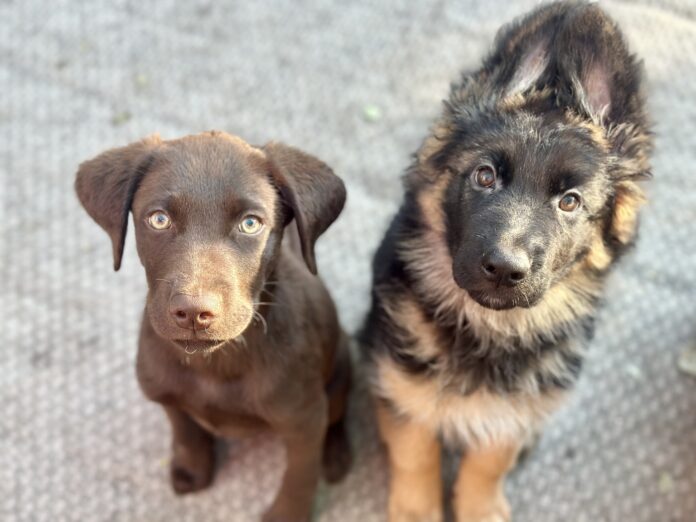
By Fran Jewell
We all know how incredibly important early baby experiences are for human children. We have wonderful mobiles for them to watch while in their cradle. We leave beautiful lights twirling around the room at night, play music for them to listen to when they sleep and read to them every chance we get.
Puppies are exactly the same in that they are sponges of learning even the second or third day after birth. The military created and studied the Early Neurological Stimulation process for puppies to learn how to cope with stimulus they would never get otherwise, which makes them more resilient to stress and better learners. With my puppies, I add scent stimulus of flowers, fruit, even essential oils used for nose-work competition. It is simply incredible to see a four-day-old puppy, with no eyes open or the ability to hear, follow the scent of something new! This ENS program is no different from the entire baby learning we do with mobiles and ocean/soothing sounds for the human baby.
What is even more astonishing is that puppies can learn simple things like sit and down by the time they are just THREE WEEKS OLD!!! They can even learn to start retrieving small objects! By the time they are four weeks old, they are off and running and able to learn about social behaviors like eating together, having human hands petting them while they eat, even learning their names!
The sad thing is that many people think that obedience training shouldn’t start until a puppy is 6 MONTHS OLD! By then, the puppy has learned huge amounts by way of his own exploration. He learns that the grass smells good and that those odors are better than your voice calling him. He learns that if he jumps, he gets petted by friendly strangers. He also learns that if he growls when someone comes near his food dish, he gets left alone.
What is IMPERATIVE for us to do is to direct that learning and teach him to focus on us in order for us to even have a relationship with him. If we allow him to just explore all on his own, without direction, he will continue to do that for the rest of his life. Exploring and performing natural instinctive behaviors is a GREAT thing, but if we want a responsive dog, we need to direct those instincts and we need to teach him early that his behaviors must fit in with our human world.
What few people really understand is that what we teach our puppy FIRST is what he will do when he is stressed, over-aroused or excited. Exactly what that means is that whatever we reward the first day he comes home is what he will do when he doesn’t know what else to do. SO, if we want our puppy to be a polite greeter, we must make sit be our priority in teaching immediately — sit for everything. Sit at the door to go out, sit for petting, sit for food, and sit for toys, and so on.
My best example was my first purebred German shepherd, Giselle. I got her to do competition with including the conformation ring. So, the very first thing I taught her as an itty-bitty baby was the German shepherd “stack,” with her front legs together, and one back leg under her while the other back leg was set exactly perpendicular to the ground. It takes a lot of work. But, I figured if I wanted to take her into the show ring, I knew she would get nervous. If the first thing she was taught was her stack, she would do that automatically. It worked! When she got into the show ring, she was wonderful and so easy to handle. In fact, whenever she was unsure of any situation throughout the rest of her life, she would do her German shepherd stack. It was amazing!
With Kalidor, I started man tracking with him at nine weeks old! At his first tracking test the judge came up to me and said, “It was an honor to watch your dog track today!” Needless to say, I was so honored myself that a judge would say that to me.
If we want a hunting dog, we should be teaching our dog hunting skills right from the get-go. If we want a tracking dog, imprint that tracking behavior. If we want a dog that doesn’t jump on every person he meets, teach him sit for everything.
As puppy owners, we want our puppy to grow up sound, stable, happy and able to live in our human environment. If we are intentional about this very simple, extremely important rule, we can set our puppy up for success easily. Before you even pick up your puppy, you should be thinking about what your goals are for your puppy. Then, immediately when that puppy comes home, start working toward that goal. Your puppy will love the work and the direction and you will find fewer behavior problems down the road. Prevention, prevention, prevention is ALWAYS the best way! Behavior intervention is always much more difficult and not always successful.
Fran Jewell is a dog behavior consultant, NADOI-certified instructor and vice president. She owns Positive Puppy Dog Training LLC and can be reached at (208) 721-7221.


